Vue.js——vue-resource全攻略
Posted Vincent-yuan
tags:
篇首语:本文由小常识网(cha138.com)小编为大家整理,主要介绍了Vue.js——vue-resource全攻略相关的知识,希望对你有一定的参考价值。
上一篇我们介绍了如何将$.ajax和Vue.js结合在一起使用,并实现了一个简单的跨域CURD示例。
Vue.js是数据驱动的,这使得我们并不需要直接操作DOM,如果我们不需要使用jQuery的DOM选择器,就没有必要引入jQuery。
vue-resource是Vue.js的一款插件,它可以通过XMLHttpRequest或JSONP发起请求并处理响应。
也就是说,$.ajax能做的事情,vue-resource插件一样也能做到,而且vue-resource的API更为简洁。
另外,vue-resource还提供了非常有用的inteceptor功能,使用inteceptor可以在请求前和请求后附加一些行为,比如使用inteceptor在ajax请求时显示loading界面。
本文的主要内容如下:
- 介绍vue-resource的特点
- 介绍vue-resource的基本使用方法
- 基于this.$http的增删查改示例
- 基于this.$resource的增删查改示例
- 基于inteceptor实现请求等待时的loading画面
- 基于inteceptor实现请求错误时的提示画面
vue-resource特点
vue-resource插件具有以下特点:
1. 体积小
vue-resource非常小巧,在压缩以后只有大约12KB,服务端启用gzip压缩后只有4.5KB大小,这远比jQuery的体积要小得多。
2. 支持主流的浏览器
和Vue.js一样,vue-resource除了不支持IE 9以下的浏览器,其他主流的浏览器都支持。
3. 支持Promise API和URI Templates
Promise是ES6的特性,Promise的中文含义为“先知”,Promise对象用于异步计算。
URI Templates表示URI模板,有些类似于ASP.NET MVC的路由模板。
4. 支持拦截器
拦截器是全局的,拦截器可以在请求发送前和发送请求后做一些处理。
拦截器在一些场景下会非常有用,比如请求发送前在headers中设置access_token,或者在请求失败时,提供共通的处理方式。
vue-resource使用
引入vue-resource
<script src="js/vue.js"></script> <script src="js/vue-resource.js"></script>
基本语法
引入vue-resource后,可以基于全局的Vue对象使用http,也可以基于某个Vue实例使用http。
// 基于全局Vue对象使用http
Vue.http.get(\'/someUrl\', [options]).then(successCallback, errorCallback);
Vue.http.post(\'/someUrl\', [body], [options]).then(successCallback, errorCallback);
// 在一个Vue实例内使用$http
this.$http.get(\'/someUrl\', [options]).then(successCallback, errorCallback);
this.$http.post(\'/someUrl\', [body], [options]).then(successCallback, errorCallback);
在发送请求后,使用then方法来处理响应结果,
then方法有两个参数,第一个参数是响应成功时的回调函数,第二个参数是响应失败时的回调函数。
then方法的回调函数也有两种写法,第一种是传统的函数写法,第二种是更为简洁的ES 6的Lambda写法:
// 传统写法
this.$http.get(\'/someUrl\', [options]).then(function(response){
// 响应成功回调
}, function(response){
// 响应错误回调
});
// Lambda写法
this.$http.get(\'/someUrl\', [options]).then((response) => {
// 响应成功回调
}, (response) => {
// 响应错误回调
});
支持的HTTP方法
vue-resource的请求API是按照REST风格设计的,它提供了7种请求API:
get(url, [options])head(url, [options])delete(url, [options])jsonp(url, [options])post(url, [body], [options])put(url, [body], [options])patch(url, [body], [options])
除了jsonp以外,另外6种的API名称是标准的HTTP方法。当服务端使用REST API时,客户端的编码风格和服务端的编码风格近乎一致,这可以减少前端和后端开发人员的沟通成本。
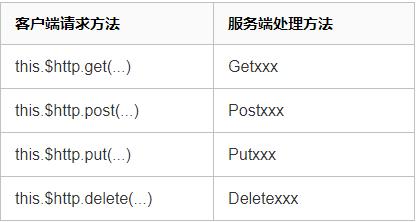
options对象
发送请求时的options选项对象包含以下属性:
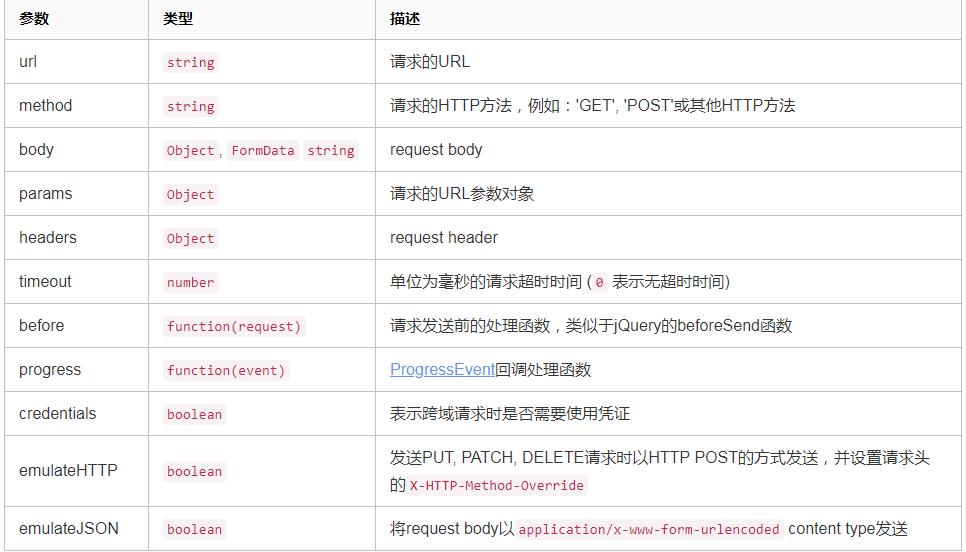
emulateHTTP的作用
如果Web服务器无法处理PUT, PATCH和DELETE这种REST风格的请求,你可以启用enulateHTTP现象。
启用该选项后,请求会以普通的POST方法发出,并且HTTP头信息的 X-HTTP-Method-Override 属性会设置为实际的HTTP方法。
Vue.http.options.emulateHTTP = true;
emulateJSON的作用
如果Web服务器无法处理编码为application/json的请求,你可以启用emulateJSON选项。
启用该选项后,请求会以 application/x-www-form-urlencoded 作为MIME type,就像普通的html表单一样。
Vue.http.options.emulateJSON = true;
response对象
response对象包含以下属性:

注意:本文的vue-resource版本为v0.9.3,如果你使用的是v0.9.0以前的版本,response对象是没有json(), blob(), text()这些方法的
CURD示例
提示:以下示例仍然沿用上一篇的组件和WebAPI,组件的代码和页面HTML代码我就不再贴出来了。
GET请求
var demo = new Vue({
el: \'#app\',
data: {
gridColumns: [\'customerId\', \'companyName\', \'contactName\', \'phone\'],
gridData: [],
apiUrl: \'http://211.149.193.19:8080/api/customers\'
},
ready: function() {
this.getCustomers()
},
methods: {
getCustomers: function() {
this.$http.get(this.apiUrl)
.then((response) => {
this.$set(\'gridData\', response.data)
})
.catch(function(response) {
console.log(response)
})
}
}
})
这段程序的then方法只提供了successCallback,而省略了errorCallback。
catch方法用于捕捉程序的异常,catch方法和errorCallback是不同的,
errorCallback只在响应失败时调用,而catch则是在整个请求到响应过程中,只要程序出错了就会被调用。
在then方法的回调函数内,你也可以直接使用this,this仍然是指向Vue实例的:
getCustomers: function() {
this.$http.get(this.apiUrl)
.then((response) => {
this.$set(\'gridData\', response.data)
})
.catch(function(response) {
console.log(response)
})
}
为了减少作用域链的搜索,建议使用一个局部变量来接收this。
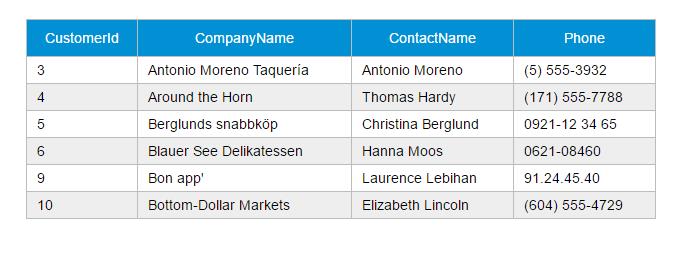
JSONP请求
getCustomers: function() {
this.$http.jsonp(this.apiUrl).then(function(response){
this.$set(\'gridData\', response.data)
})
}
POST请求
var demo = new Vue({
el: \'#app\',
data: {
show: false,
gridColumns: [{
name: \'customerId\',
isKey: true
}, {
name: \'companyName\'
}, {
name: \'contactName\'
}, {
name: \'phone\'
}],
gridData: [],
apiUrl: \'http://211.149.193.19:8080/api/customers\',
item: {}
},
ready: function() {
this.getCustomers()
},
methods: {
closeDialog: function() {
this.show = false
},
getCustomers: function() {
var vm = this
vm.$http.get(vm.apiUrl)
.then((response) => {
vm.$set(\'gridData\', response.data)
})
},
createCustomer: function() {
var vm = this
vm.$http.post(vm.apiUrl, vm.item)
.then((response) => {
vm.$set(\'item\', {})
vm.getCustomers()
})
this.show = false
}
}
})
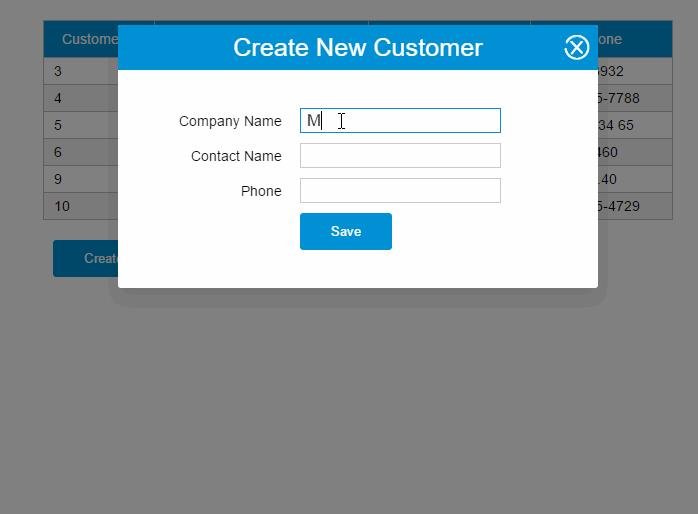
PUT请求
updateCustomer: function() {
var vm = this
vm.$http.put(this.apiUrl + \'/\' + vm.item.customerId, vm.item)
.then((response) => {
vm.getCustomers()
})
}
Delete请求
deleteCustomer: function(customer){
var vm = this
vm.$http.delete(this.apiUrl + \'/\' + customer.customerId)
.then((response) => {
vm.getCustomers()
})
}

使用resource服务
vue-resource提供了另外一种方式访问HTTP——resource服务,resource服务包含以下几种默认的action:
get: {method: \'GET\'},
save: {method: \'POST\'},
query: {method: \'GET\'},
update: {method: \'PUT\'},
remove: {method: \'DELETE\'},
delete: {method: \'DELETE\'}
resource对象也有两种访问方式:
- 全局访问:
Vue.resource - 实例访问:
this.$resource
resource可以结合URI Template一起使用,以下示例的apiUrl都设置为{/id}了:
apiUrl: \'http://211.149.193.19:8080/api/customers{/id}\'
GET请求
使用get方法发送GET请求,下面这个请求没有指定{/id}。
getCustomers: function() {
var resource = this.$resource(this.apiUrl)
vm = this
resource.get()
.then((response) => {
vm.$set(\'gridData\', response.data)
})
.catch(function(response) {
console.log(response)
})
}
POST请求
使用save方法发送POST请求,下面这个请求没有指定{/id}。
createCustomer: function() {
var resource = this.$resource(this.apiUrl)
vm = this
resource.save(vm.apiUrl, vm.item)
.then((response) => {
vm.$set(\'item\', {})
vm.getCustomers()
})
this.show = false
}
PUT请求
使用update方法发送PUT请求,下面这个请求指定了{/id}。
updateCustomer: function() {
var resource = this.$resource(this.apiUrl)
vm = this
resource.update({ id: vm.item.customerId}, vm.item)
.then((response) => {
vm.getCustomers()
})
}
{/id}相当于一个占位符,当传入实际的参数时该占位符会被替换。
例如,{ id: vm.item.customerId}中的vm.item.customerId为12,那么发送的请求URL为:
http://211.149.193.19:8080/api/customers/12
DELETE请求
使用remove或delete方法发送DELETE请求,下面这个请求指定了{/id}。
deleteCustomer: function(customer){
var resource = this.$resource(this.apiUrl)
vm = this
resource.remove({ id: customer.customerId})
.then((response) => {
vm.getCustomers()
})
}
使用inteceptor
拦截器可以在请求发送前和发送请求后做一些处理。
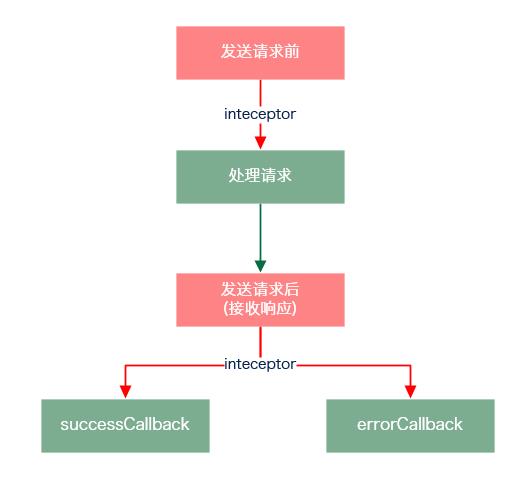
基本用法
Vue.http.interceptors.push((request, next) => {
// ...
// 请求发送前的处理逻辑
// ...
next((response) => {
// ...
// 请求发送后的处理逻辑
// ...
// 根据请求的状态,response参数会返回给successCallback或errorCallback
return response
})
})
在response返回给successCallback或errorCallback之前,你可以修改response中的内容,或做一些处理。
例如,响应的状态码如果是404,你可以显示友好的404界面。
如果不想使用Lambda函数写法,可以用平民写法:
Vue.http.interceptors.push(function(request, next) {
// ...
// 请求发送前的处理逻辑
// ...
next(function(response) {
// ...
// 请求发送后的处理逻辑
// ...
// 根据请求的状态,response参数会返回给successCallback或errorCallback
return response
})
})
示例1
之前的CURD示例有一处用户体验不太好,用户在使用一些功能的时候如果网络较慢,画面又没有给出反馈,用户是不知道他的操作是成功还是失败的,他也不知道是否该继续等待。
通过inteceptor,我们可以为所有的请求处理加一个loading:请求发送前显示loading,接收响应后隐藏loading。
具体步骤如下:
1.添加一个loading组件
<template id="loading-template"> <div class="loading-overlay"> <div class="sk-three-bounce"> <div class="sk-child sk-bounce1"></div> <div class="sk-child sk-bounce2"></div> <div class="sk-child sk-bounce3"></div> </div> </div> </template>
2.将loading组件作为另外一个Vue实例的子组件
var help = new Vue({
el: \'#help\',
data: {
showLoading: false
},
components: {
\'loading\': {
template: \'#loading-template\',
}
}
})
3.将该Vue实例挂载到某个HTML元素
<div id="help"> <loading v-show="showLoading"></loading> </div>
4.添加inteceptor
Vue.http.interceptors.push((request, next) => {
loading.show = true
next((response) => {
loading.show = false
return response
});
});

示例2
当用户在画面上停留时间太久时,画面数据可能已经不是最新的了,这时如果用户删除或修改某一条数据,如果这条数据已经被其他用户删除了,服务器会反馈一个404的错误,
但由于我们的put和delete请求没有处理errorCallback,所以用户是不知道他的操作是成功还是失败了。
你问我为什么不在每个请求里面处理errorCallback,这是因为我比较懒。这个问题,同样也可以通过inteceptor解决。
1. 继续沿用上面的loading组件,在#help元素下加一个对话框
<div id="help"> <loading v-show="showLoading" ></loading> <modal-dialog :show="showDialog"> <header class="dialog-header" slot="header"> <h1 class="dialog-title">Server Error</h1> </header> <div class="dialog-body" slot="body"> <p class="error">Oops,server has got some errors, error code: {{errorCode}}.</p> </div> </modal-dialog> </div>
2.给help实例的data选项添加两个属性
var help = new Vue({
el: \'#help\',
data: {
showLoading: false,
showDialog: false,
errorCode: \'\'
},
components: {
\'loading\': {
template: \'#loading-template\',
}
}
})
3.修改inteceptor
Vue.http.interceptors.push((request, next) => {
help.showLoading = true
next((response) => {
if(!response.ok){
help.errorCode = response.status
help.showDialog = true
}
help.showLoading = false
return response
});
});
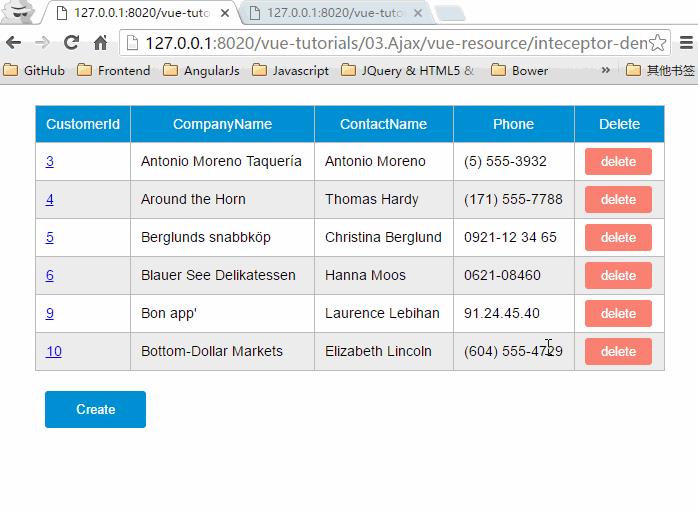
总结
vue-resource是一个非常轻量的用于处理HTTP请求的插件,它提供了两种方式来处理HTTP请求:
- 使用Vue.http或this.$http
- 使用Vue.resource或this.$resource
这两种方式本质上没有什么区别,阅读vue-resource的源码,你可以发现第2种方式是基于第1种方式实现的。
inteceptor可以在请求前和请求后附加一些行为,这意味着除了请求处理的过程,请求的其他环节都可以由我们来控制。
以上是关于Vue.js——vue-resource全攻略的主要内容,如果未能解决你的问题,请参考以下文章